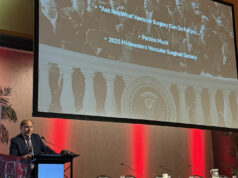
William A. Marston, MD, was recalling a recent experience acting as a bone marrow donor for a family member, and the moment it dawned on him, after the harvesting procedure with a specialist in the field, the true value of the knowledge, skill and training it takes to make the routine routine in his own domain of vascular disease treatment.
“In our world, this is devalued,” said the vascular surgery division chief at the University of North Carolina at Chapel Hill. He was addressing the 2022 Southern Association for Vascular Surgery (SAVS) annual meeting (Jan. 19–22) in Manalapan, Florida, his swansong as SAVS president. “These procedures are life and limb saving,” he told attendees. “The things that we do, we do them every day—but we don’t internalize or appreciate it. We need to, both personally and collectively.”
Marston provided a prescription for his peers struggling to fully appreciate what it is they do day after day.
“Take satisfaction in providing good patient care, even if it’s not procedural. If you advise someone not to have a procedure, that may sometimes be the best thing that you could do,” he said. “And we do this well at this association: that is, talk about complications and bad outcomes. Let’s learn from them, not hide from them, and acknowledge that they occur.
“Support your peers, talk to each other; we all have complications, be realistic about them. And sometimes, amputation is the best option for our patients. Sometimes it’s best to leave the aneurysm alone.”
Beware comparing yourself to podium experts, Marston continued. “Most of us are experts in little narrow things. When we talk about some great case we did, for me it might be a vena cava reconstruction. But I don’t do complex aneurysms with Mark Farber around. I don’t do retrograde pedal access. So, if you’re treating a broad selection of vascular patients, do a good job, do the best techniques you can and sleep well with it.”
He titled his address around the concept of the vascular surgeon and what might be “the right stuff” for practitioners—a play on the eponymous 1980s movie about the pioneering days of the U.S. space development program and the space race’s symmetry with the swashbuckling gestation period of the vascular surgical specialty.
“In the movie,” Marston said, “astronauts competed to be the first; they all wanted to be the first in space, and that had to be the best one. But I believe that today, in 2022, the right stuff should be defined by the collective success of a program to provide focused care for the largest population of patients with vascular disease possible. To achieve this, we need vascular surgeons of all backgrounds, all races, all ethnicities with the diversity to deliver care to all patients with vascular disease.”












